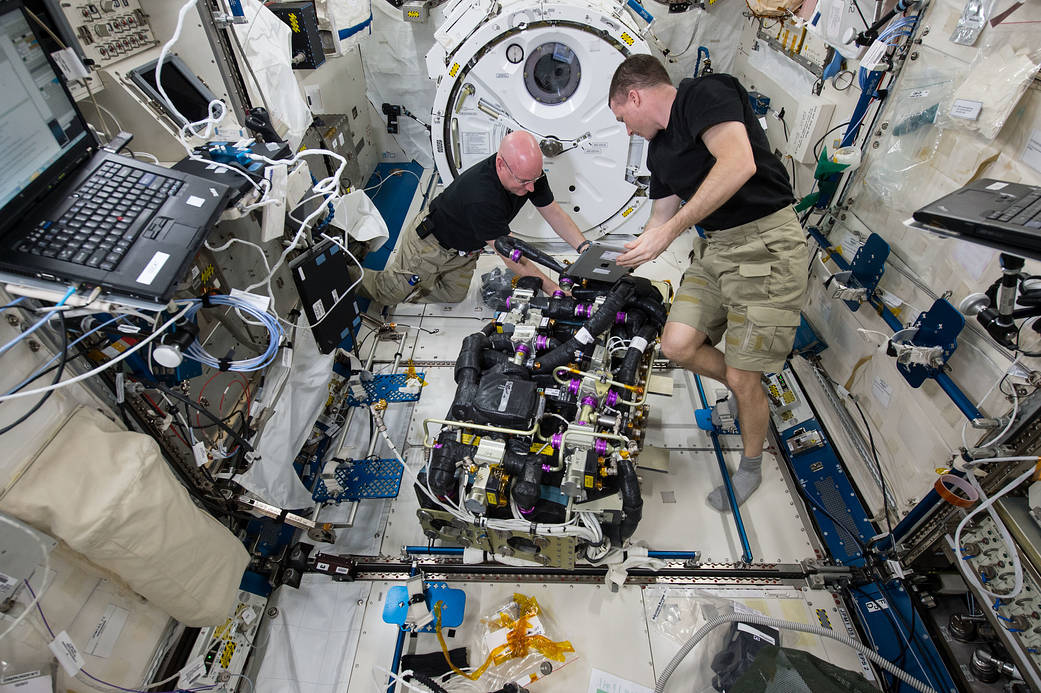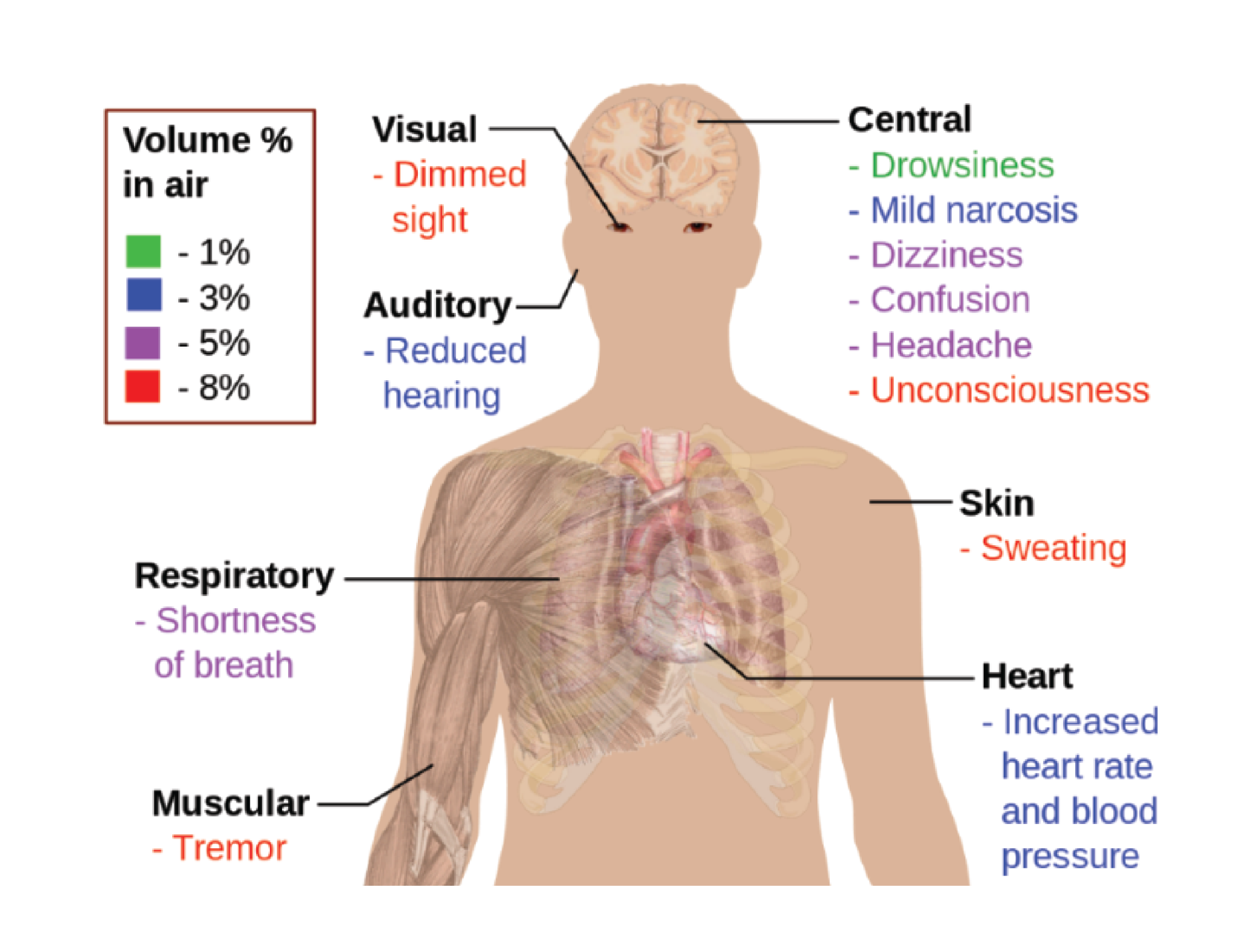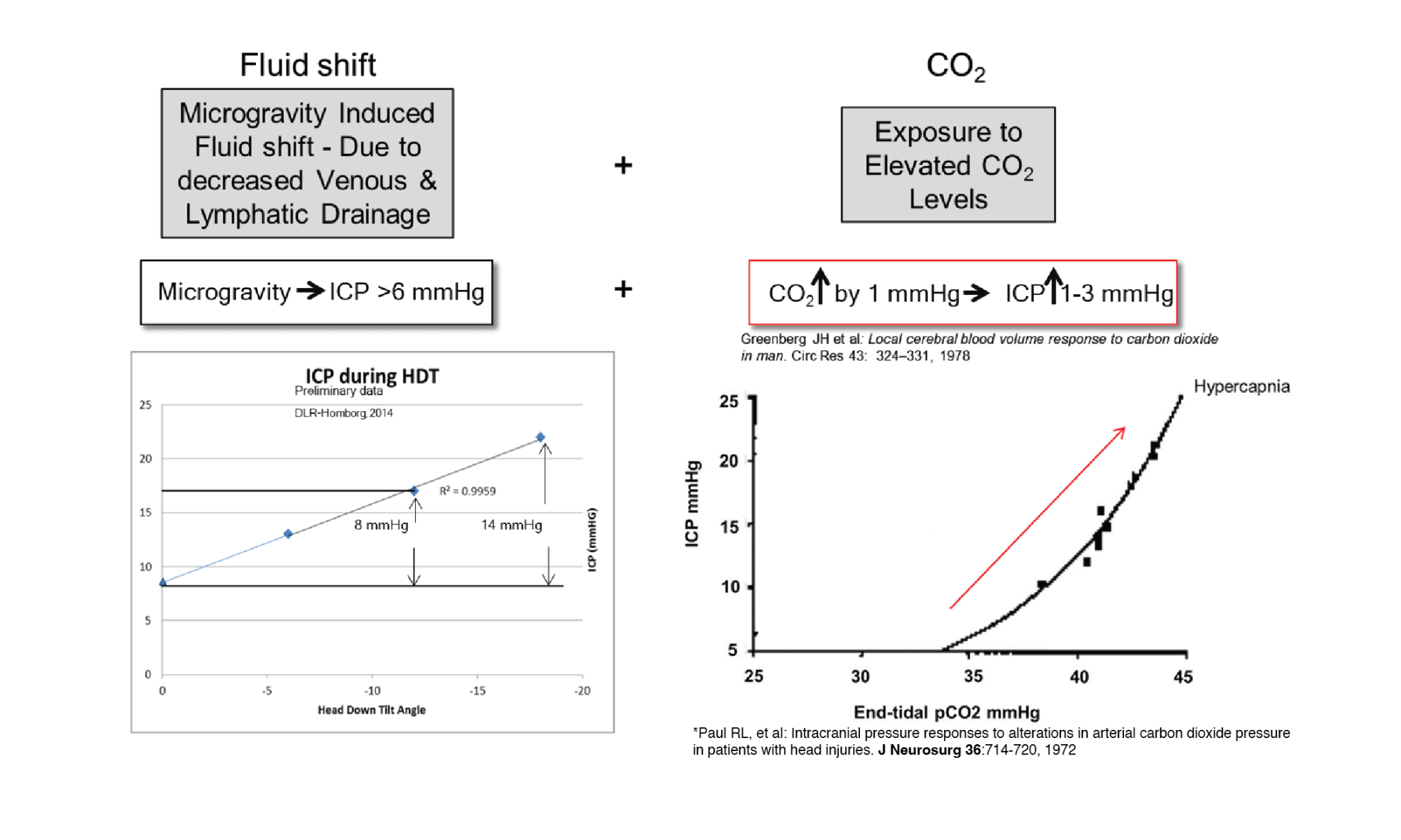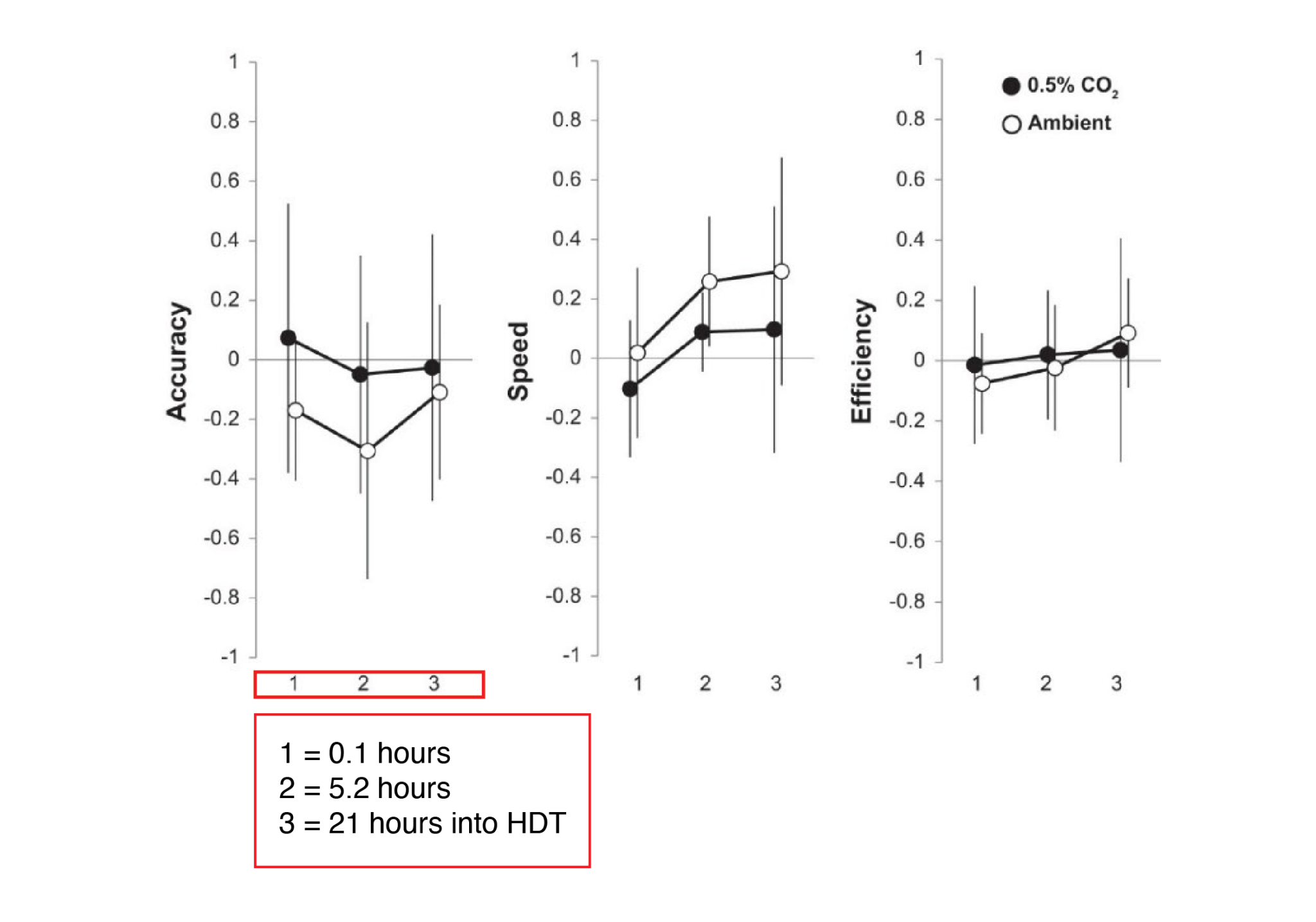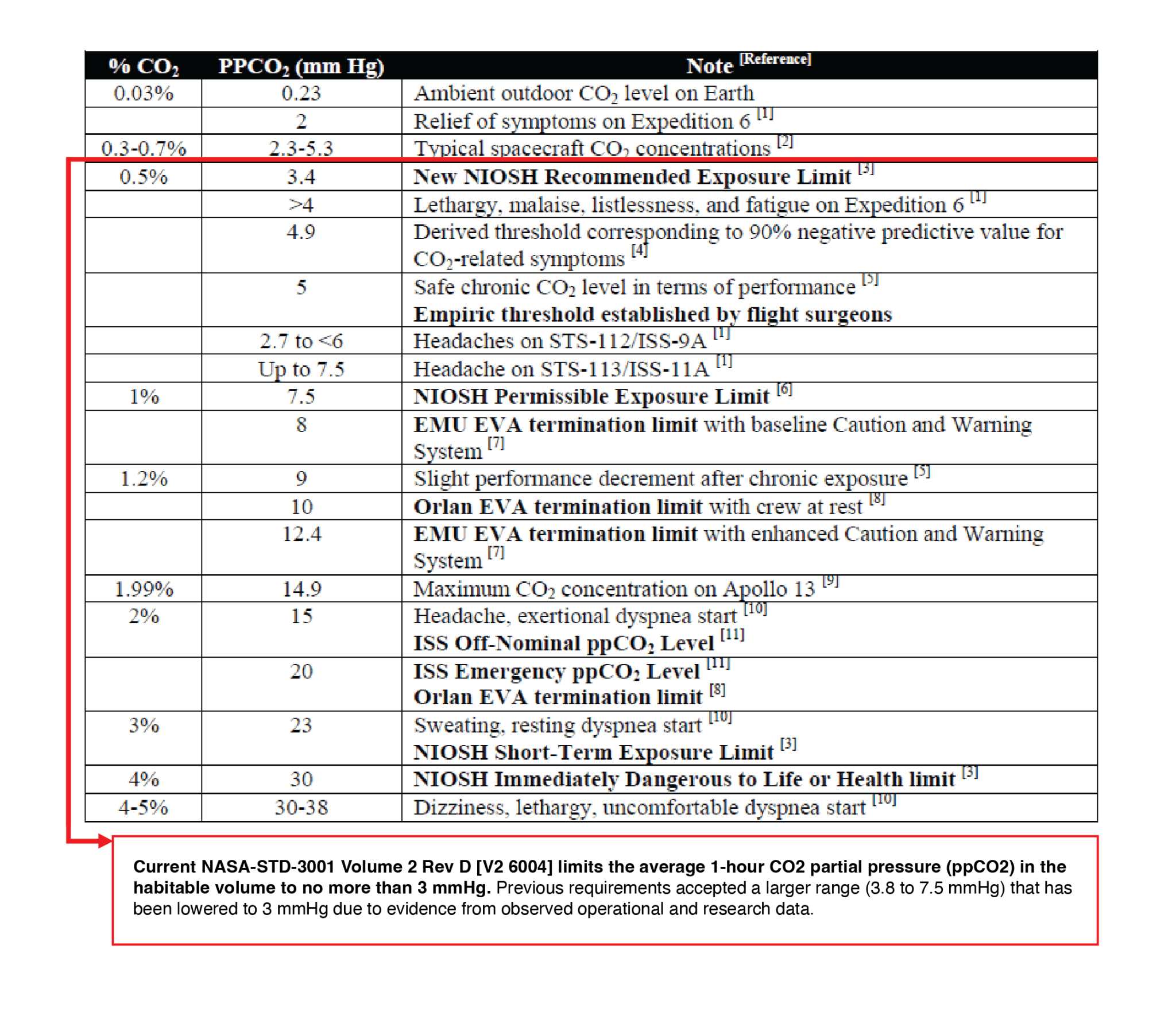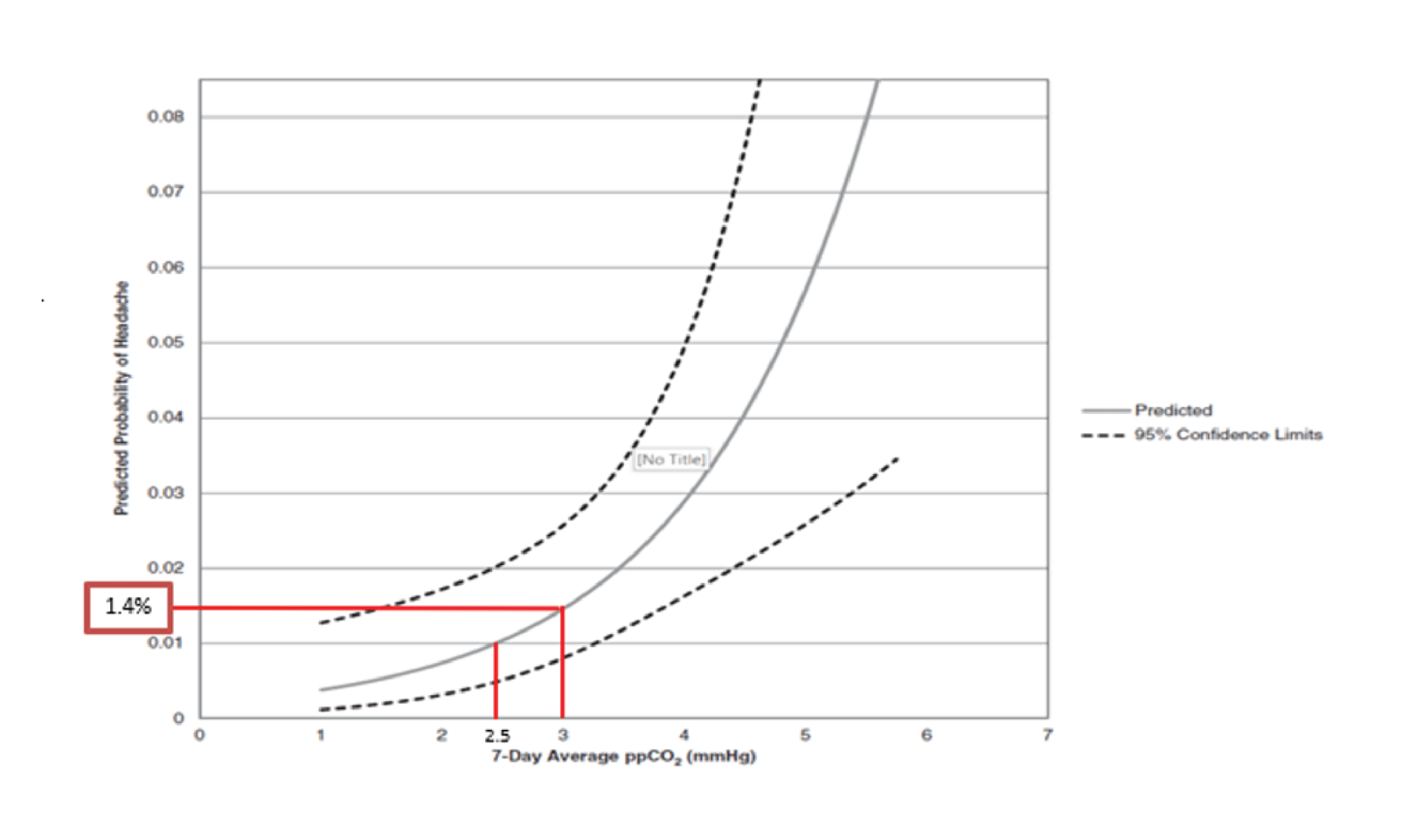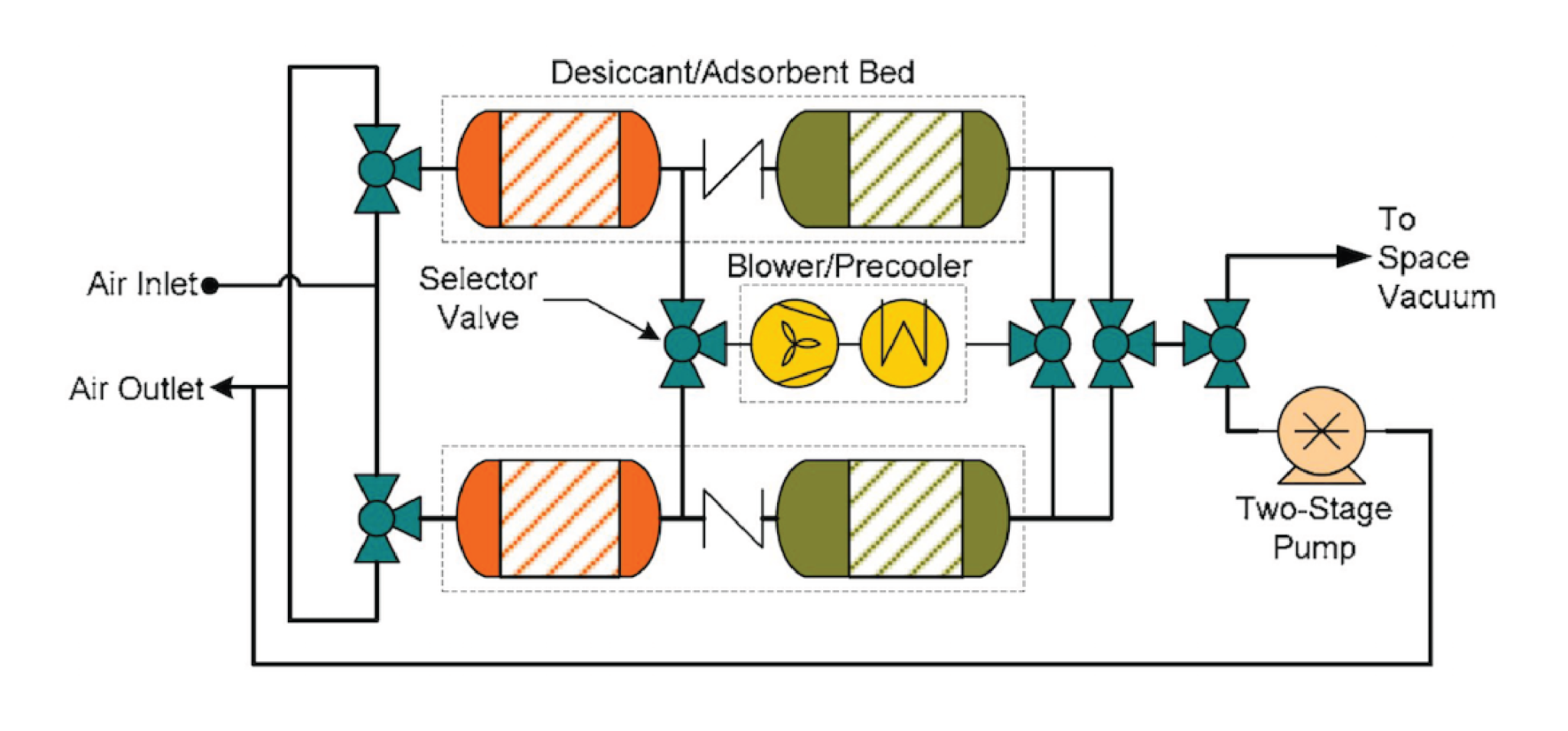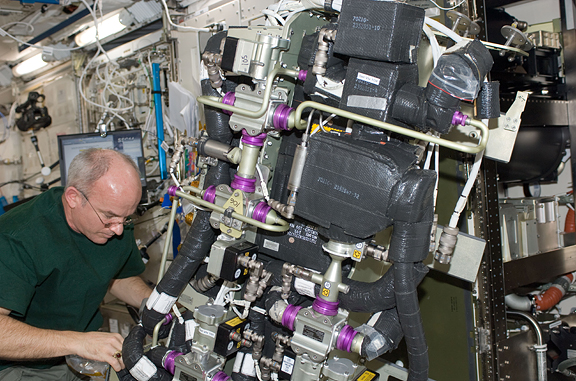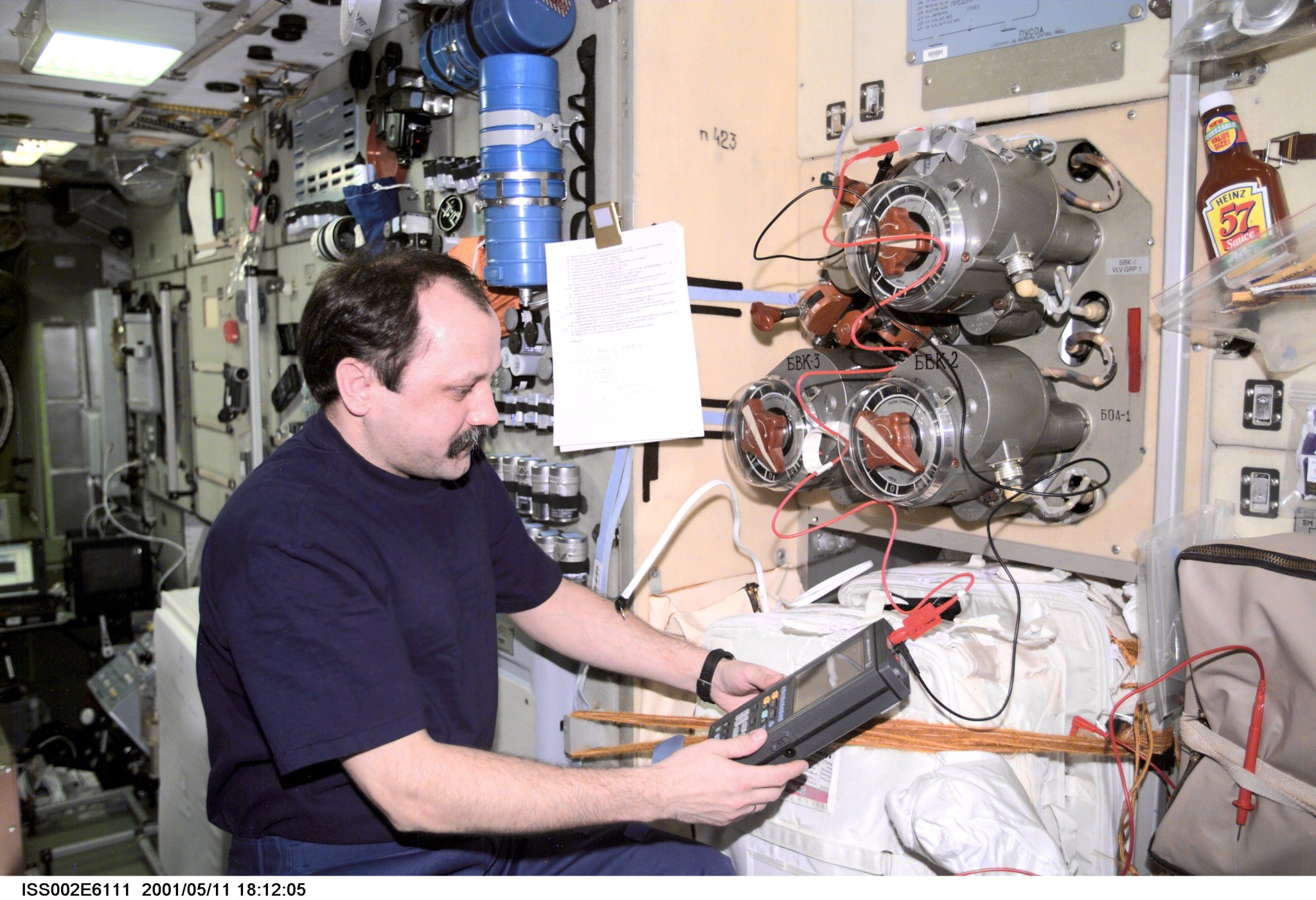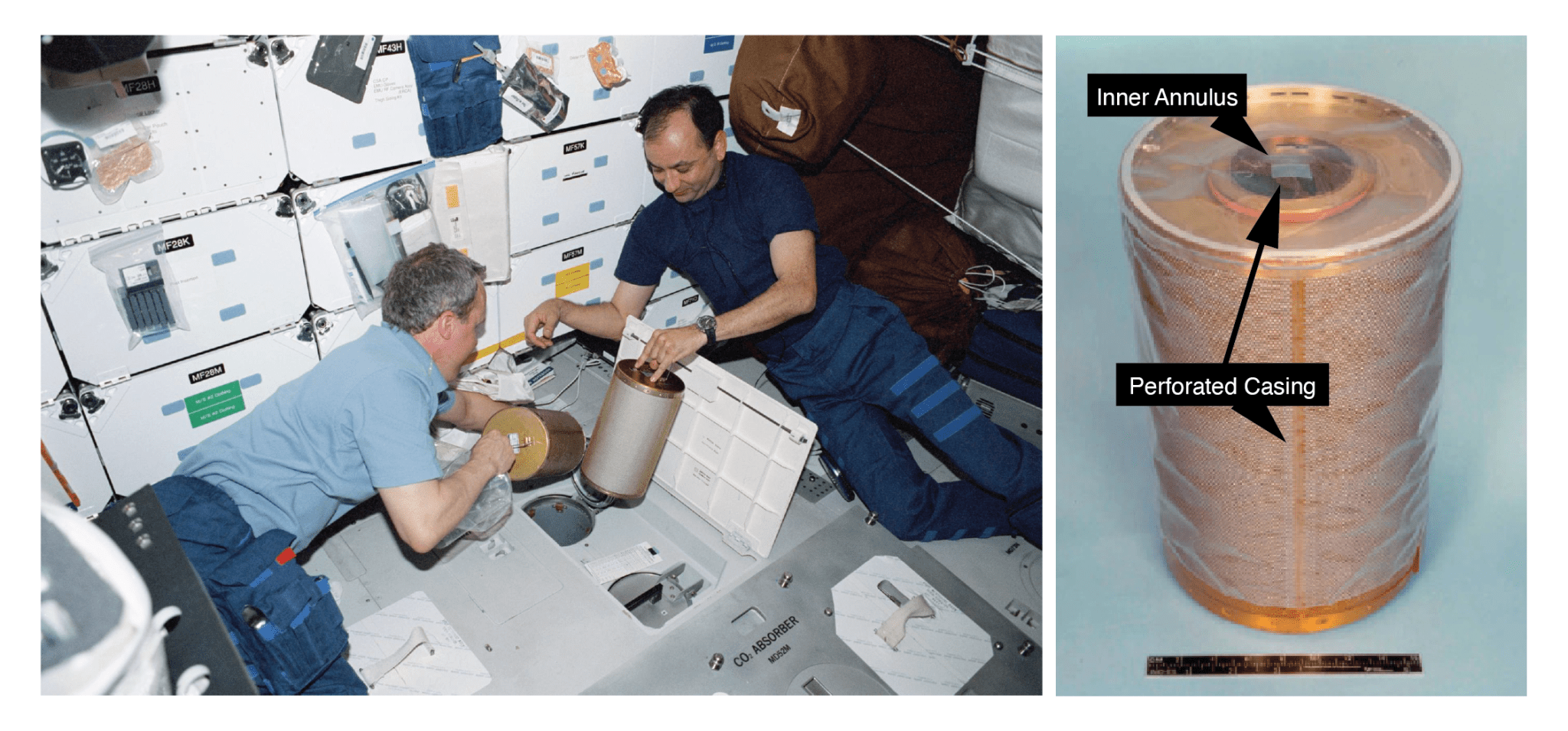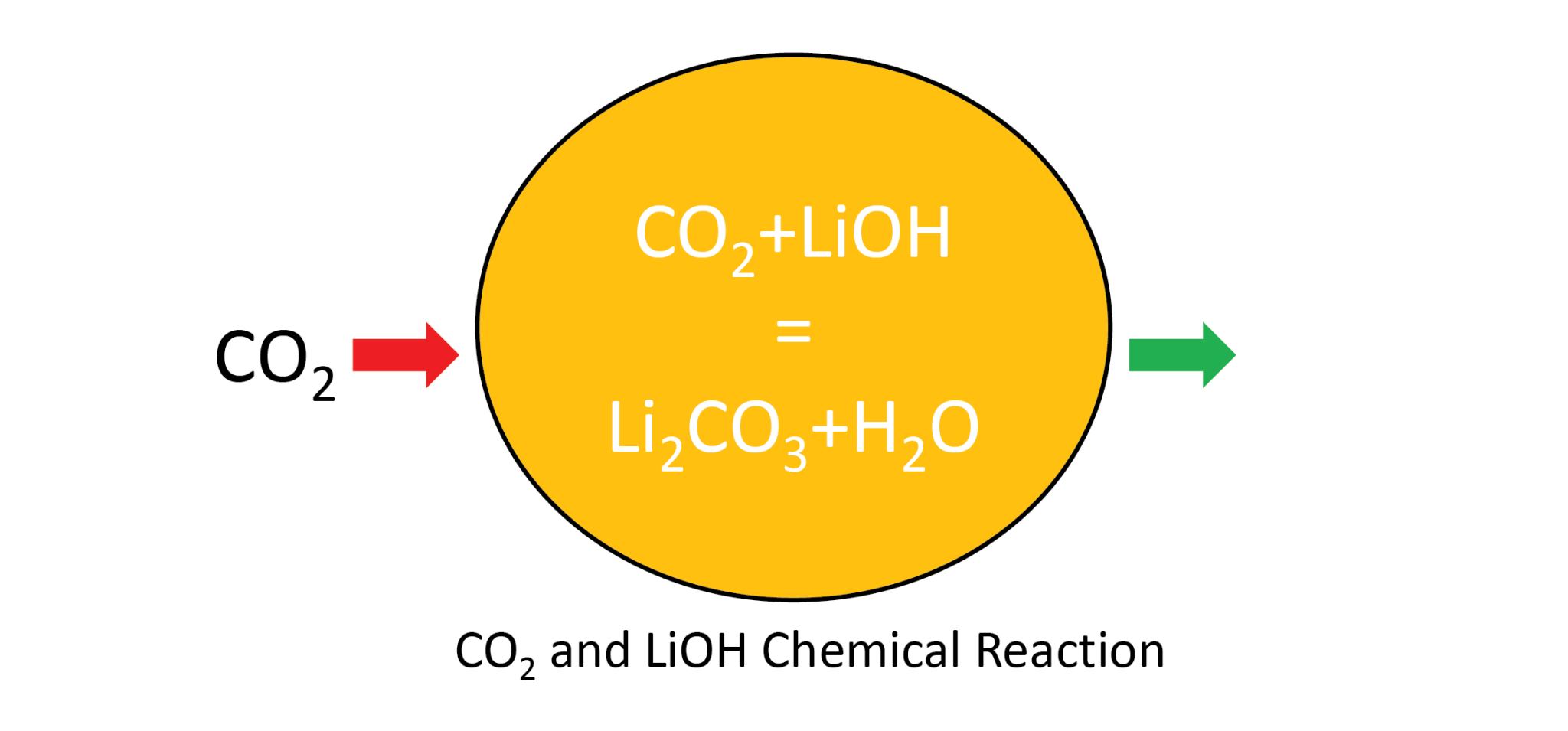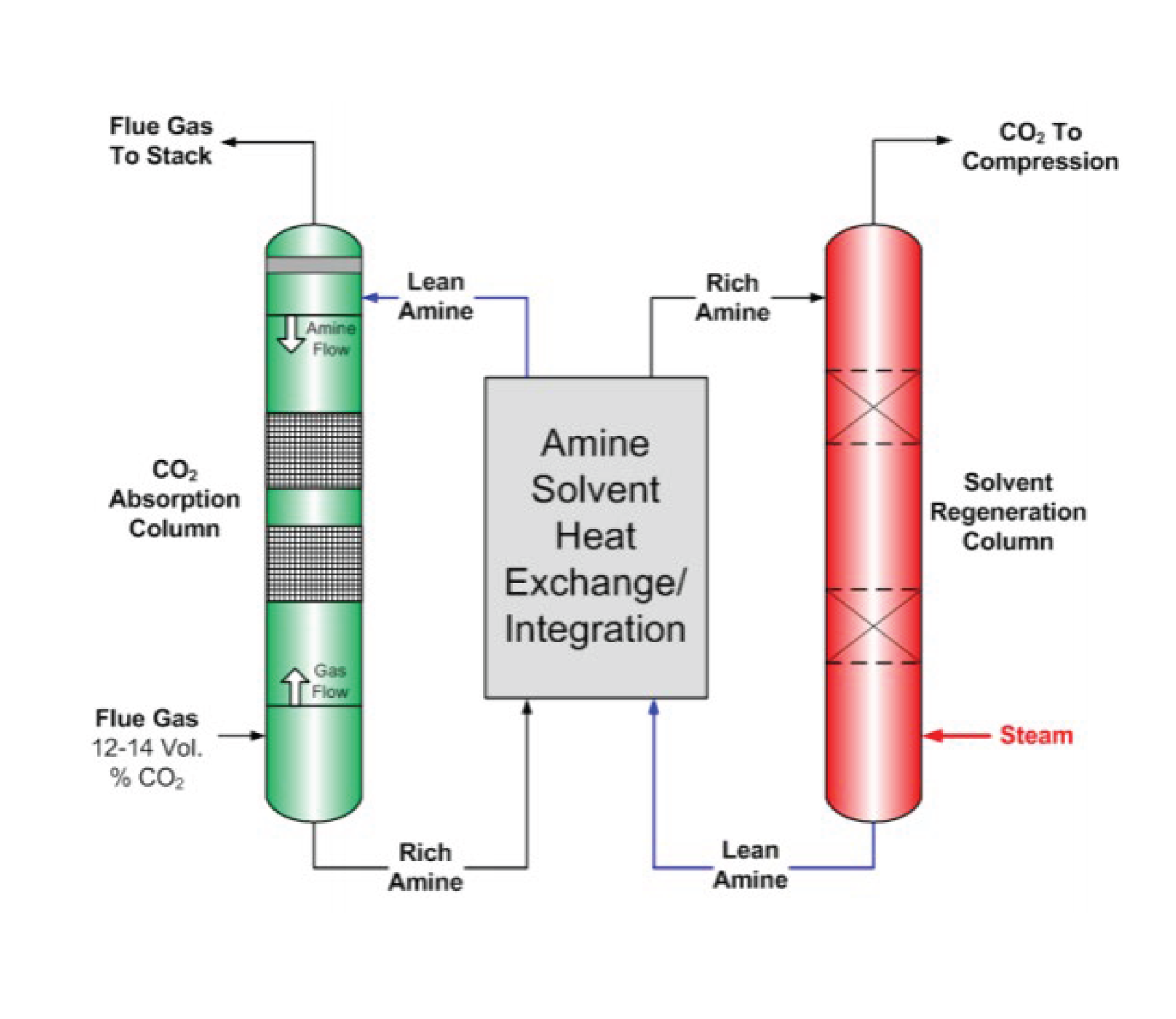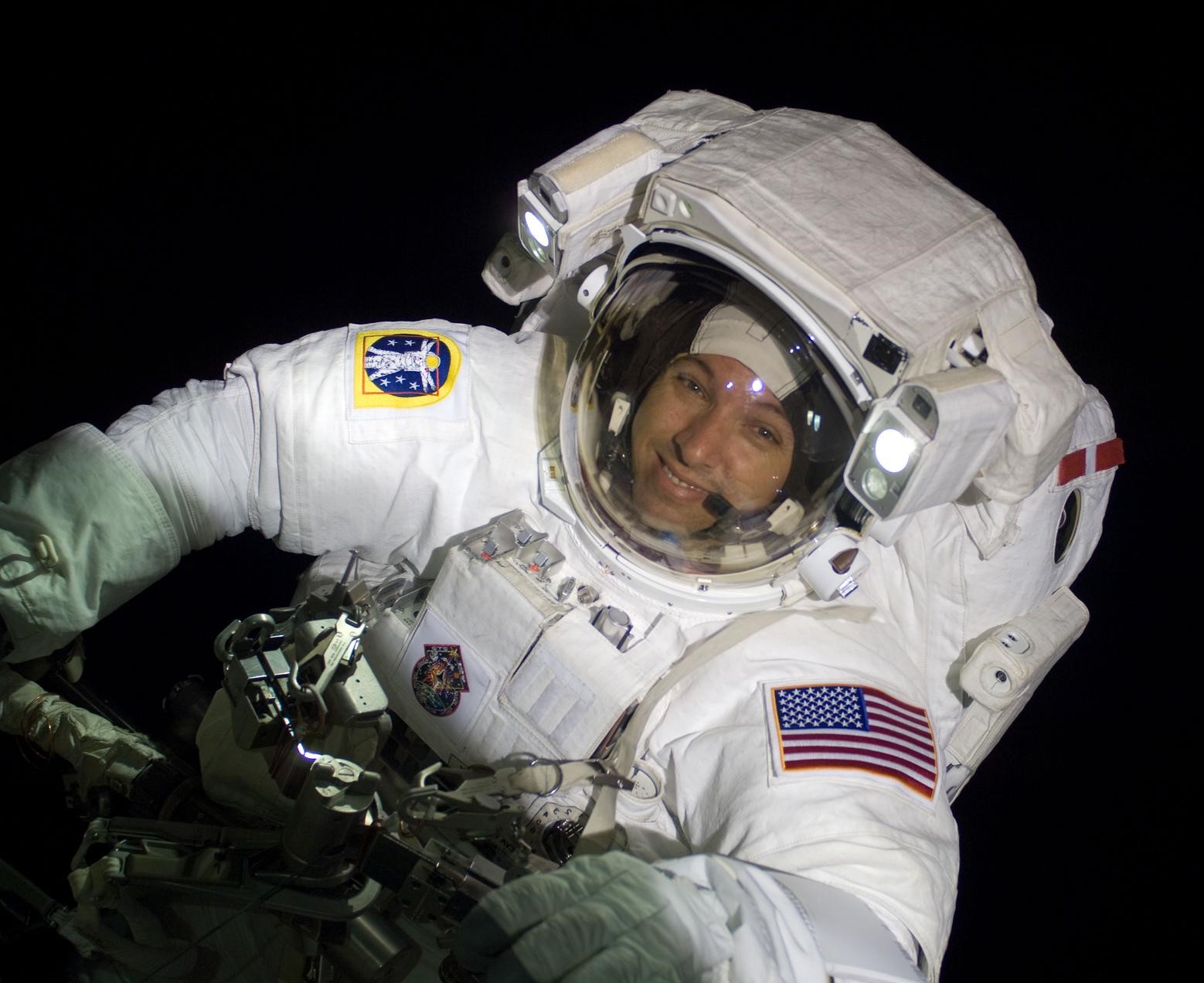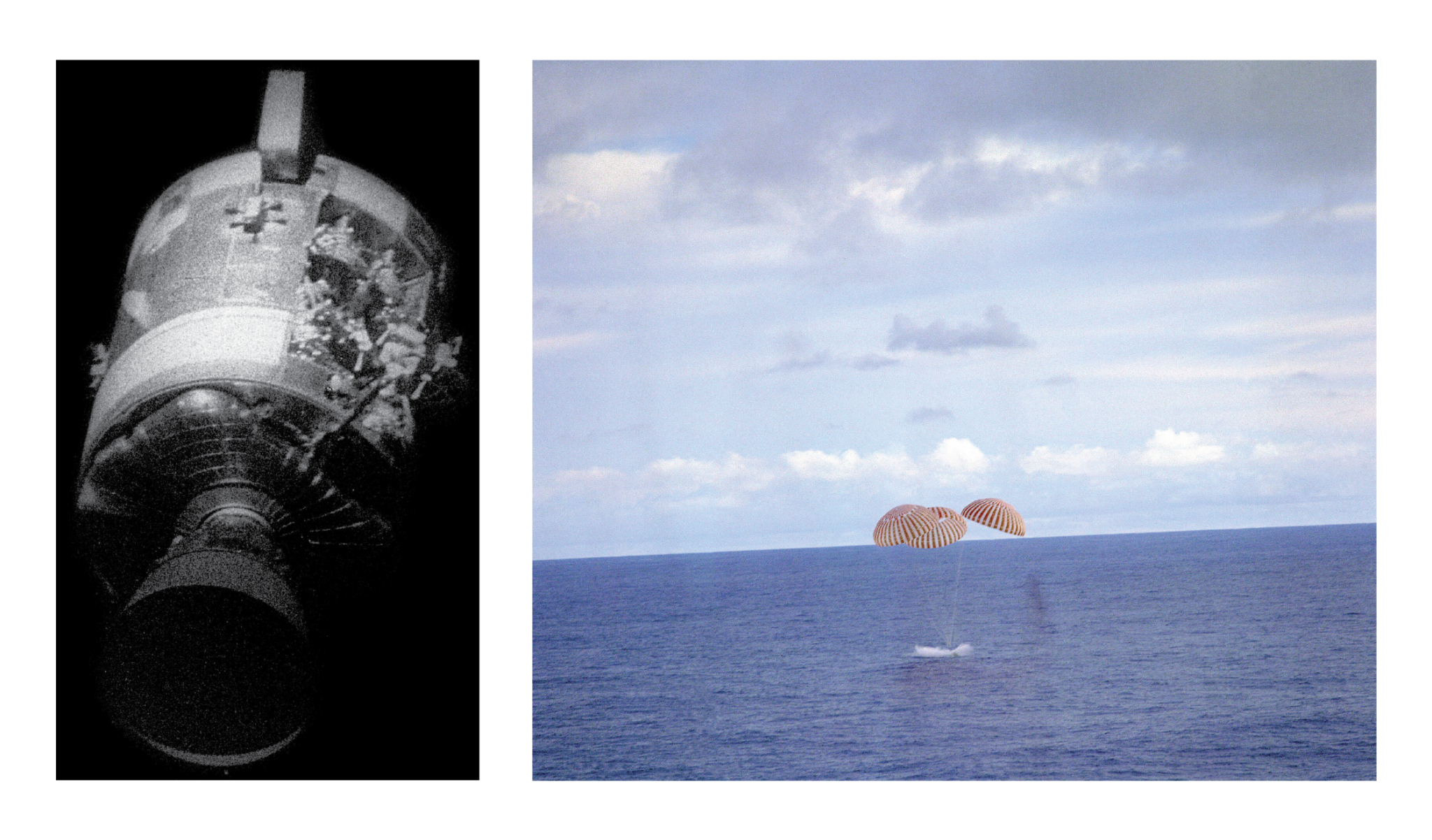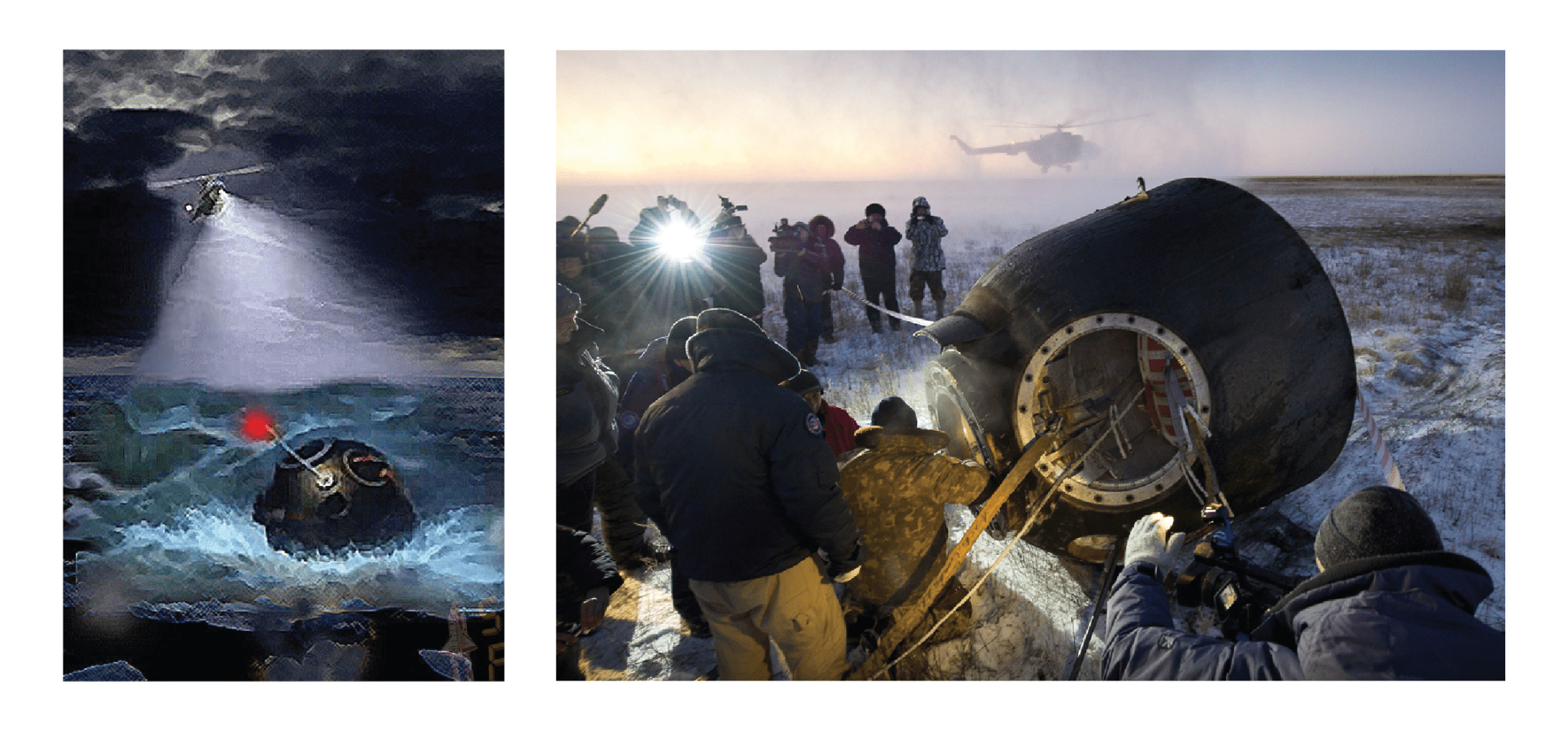Executive Summary
On Earth, physiological Carbon Dioxide (CO2) levels are managed by our lungs and environment. Our lungs collect vital oxygen (O2) through inhalation, circulate O2 throughout our body and to vital organs via the bloodstream, and then upon exhale, release CO2 into the environment. When our respiratory system does not function nominally, either from physical or environmental limits, CO2 can build-up in our bodies (hypercapnia) and cause symptoms such as headache, dyspnea, fatigue, and in extreme cases, death. Our environment naturally eliminates CO2 through photosynthesis of plants and trees, weathering, and other experimental CO2 removal processes. Humans in space face hostile, enclosed environments (including vehicles and suits) that do not have the benefit of natural CO2 removal, relying on CO2 removal equipment (e.g., the Carbon Dioxide Removal Assembly (CDRA), lithium hydroxide, and amine systems) to help regulate CO2 levels in the environment and help decrease risk of negative consequences of elevated CO2 exposure.
Relevant NASA-STD-3001 Technical Requirements
Volume One
- [V1 3003] In-Mission Preventive Health Care
- [V1 3004] In-Mission Medical Care
- [V1 5002] Crewmember Training
- [V1 5009] Physiological Exposure Mission Training
Volume Two
- [V2 4015] Aerobic Capacity
- [V2 6001] Trend Analysis of Environmental and Suit Data
- [V2 6004] Nominal Vehicle/Habitat Carbon Dioxide Levels
- [V2 6006] Total Pressure Tolerance Range for Indefinite Crew Exposure
- [V2 6020] Atmospheric Data Recording
- [V2 6021] Atmospheric Data Displaying
- [V2 6022] Atmospheric Monitoring and Alerting Parameters
- [V2 6107] Nominal Vehicle/Habitat Atmospheric Ventilation
- [V2 6108] Off-Nominal Vehicle/Habitat Atmospheric Ventilation
- [V2 7038] Physiological Countermeasures Capability
- [V2 7041] Environmental Control During Exercise
- [V2 11034] Suited Atmospheric Data Recording
- [V2 11035] Suited Atmospheric Data Displaying
- [V2 11036] Suited Atmospheric Monitoring and Alerting
- [V2 11037] EVA Suited Metabolic Rate Measurement
- [V2 11038] EVA Suited Metabolic Rate Display
- [V2 11039] Nominal Spacesuit Carbon Dioxide Levels
Background
Main Symptoms of CO2 Toxicity (Hypercapnia)
These symptoms represent potential side-effects of hypercapnia, however it is important to note that most of these symptoms have never been observed during spaceflight.
- The most common symptoms experienced during spaceflight are headaches and vision changes (Spaceflight Associated Neuro-ocular Syndrome [SANS]).
- These two symptoms are commonly linked to fluid shifts and potential increase in intra-cranial pressure (ICP) due to the microgravity environment in spaceflight.
Effects of CO2 on Cognitive Functioning
Prior research offers conflicting data on CO2 exposure and the effects on cognitive functioning, including memory, concentration, decision-making, and task performance. However, several recent terrestrial studies have shown the CO2 exposure at levels currently maintained onboard spacecraft and submarines does not reduce cognition and performance in astronaut-like subjects or submarine officers.
- Effects of acute exposures to carbon dioxide on decision-making and cognition in astronaut-like subjects (Scully et al., 2019). Findings state “There were no clear dose-response patterns for performance on either Strategic Management Simulation or Cognition”.
- Acute Exposure to Low-to-Moderate Carbon Dioxide Levels and Submariner Decision Making (Rodehe et al., 2018). Findings state “There were no significant differences for any of the nine Strategic Management Simulation measures of decision making between CO2 exposure conditions”.
- Effects of -12° head-down tilt with and without elevated levels of CO2 on cognitive performance: the SPACECOT study (Basner et al., 2017). Findings state “There were no statistically significant time-in-CO2 effects for any cognitive outcome”.
Effects of −12° head-down tilt (HDT) with and without elevated CO2 on cognitive performance
The chart represents a summary of results from a subset of tests from a widely used and validated neurocognitive battery, the Penn Computerized Neurocognitive Battery, as well as a number of additional tests that have either been used extensively in spaceflight or that assess cognitive domains of particular interest in spaceflight (including spatial orientation, emotion recognition, and risk decision making).
Displayed data reflect Standard Deviation (SD) units. Error bars reflect 95% confidence intervals. A confidence interval that does not include 0 indicates a statistically significant difference relative to baseline data collection (BDC) atP< 0.05. The only outcomes with a significant time-in-HDT main effect in both the discrete and the continuous exposure duration models were physical exhaustion (P= 0.0012 andP= 0.0043, respectively) and mental fatigue (P= 0.0328 andP= 0.0205, respectively). The severity of these symptoms increased with increasing exposure duration. 0.5% CO2= 3.8 mmHg CO2.
Key Historical CO2 Concentrations
Anecdotal evidence from previous spaceflight missions have found the following associations between CO2levels and symptomology:
- Headaches at levels between 2.8-4.5 mmHg; worsening with increasing levels of CO2accompanied by fatigue and malaise flushing.
- Fatigue malaise, decreased sleep, and nausea reported at levels above 4.5 mmHg.
- 5th cranial nerve dysesthesia at 4.5-5.0 mmHg.
- Chronic cough, poor sleep, blurred vision, and frontal headaches reported at 3.5 mmHg.
CO2 Induced Headaches
Research and past historical data has revealed an association between reported headaches and CO2levels among crewmembers.
- A study of data collected from Expeditions 2 to 31 (N=49) found that CO2 level, age at launch, time in-flight, and data source were significantly associated with reported headaches on the ISS.
- 19 of the 49 astronauts reported experiencing headaches (~38.7%).
- To keep the risk of headache below 1%, average 7-day CO2needs to be maintained below 2.5 mmHg (current ISS range: 1 to 9 mmHg; 3001 standard requires <3 mmHg).
- Most experienced headaches were moderate intensity, requiring the use of analgesics in many cases.
- A retrospective analysis of the case reports found a total of 46 days with reported headaches and 1,670 days of non-reports (no headaches observed).
- Based on this data, the current NASA-STD-3001 Volume 2 Rev D [V2 6004] limits the average 1-hour CO2partial pressure (ppCO2) in the habitat volume to no more than 3 mmHg to keep incidence of headaches below 1.4%.
Figure: Predicted probability of headache on the basis of average 7-day CO2 levels
Some observations suggest that what appears to be increased CO2sensitivity during spaceflight may actually be attributed to individual predisposition to CO2retention, adaption to microgravity, and local fluctuations of CO2that are not measured by fixed sensors (Law, Watkins, & Alexander, 2010). Fluid shift due to decreased venous and lymphatic drainage in microgravity largely contributes to symptoms similar to CO2over-exposure, including headaches.
Reference Information
Contributors to CO2 Levels During Spaceflight
- On earth, average indoor air contains CO2 concentrations between 0.08% to 0.1% (0.608 to 0.76 mmHg).
- NASA-STD-3001 Volume 2 Rev D [V2 6004]: The system shall limit the average one-hour CO2 partial pressure (ppCO2) in the habitable volume to no more than 3 mmHg.
Crew-Induced Metabolic Loads for a Standard Mission Day with Exercise
| Crewmember Activity Description | Duration of Activity (hr) | O2 Consumption kg/min 10-4 (lbm/min 10-4) | CO2 Output kg/min 10-4 (lbm/min 10-4) |
|---|---|---|---|
| Sleep | 8 | 3.60 (7.94) | 4.55 (10.03) |
| Nominal | .25 | 5.68 (12.55) | 7.2 (15.87) |
| Exercise 0-15 min at 75% VO2 max | .25 | 39.40 (86.86) | 49.85 (109.90) |
| Exercise 15-30 min at 75% VO2 max | .25 | 39.40 (86.86) | 49.85 (109.90) |
| Recovery 0-15 min post 75% VO2 max | .25 | 5.68 (12.55) | 7.2 (15.86) |
| Recovery 15-30 min post 75% VO2 max | .25 | 5.68 (12.55) | 7.2 (15.86) |
| Recovery 30-45 min post 75% VO2 max | .25 | 5.68 (12.55) | 7.2 (15.86) |
| Recovery 45-60 min post 75% VO2 max | .25 | 5.68 (12.55) | 7.2 (15.86) |
| Total Per Day | 24 | 0.82 (1.80) | 1.04 (2.29) |
| Total Per Day (no exercise) | 24 | 0.72 (1.59) | 0.91 (2.00) |
- Respiratory quotient (RQ) is used in calculations of basal metabolic rate when estimated from CO2 production. It is calculated from the ratio of CO2 produced to O2 consumed by the body (RQ= CO2 eliminated/ O2 consumed). The RQ value is linked to intake of macronutrients (carbohydrates and fats). An RQ of 0.92 is assumed for the O2 consumption and CO2 output determinations in the table above. Modifying crew diet can help lower the environmental CO2 output levels (example: consuming more fats and less carbohydrates). See Da Poian, et al. (2010). Nutrient Utilization in Humans: Metabolism Pathways.
Application
Existing Technology
Carbon Dioxide Removal Assembly (CDRA) on the ISS (International Space Station):
- CDRA continuously removes six person-equivalent of CO2, when operating with both CO2 removal beds (dual beds functioning).
- Minimum ISS CO2 removal rate is based on the equation for human equivalent unit (HEU) with the CO2 partial pressure ranging from 2.0 to 3.9 mmHg.
- The CDRA houses a four-bed molecular sieve (4BMS) that utilize zeolite crystals composed of silicon, aluminum, and oxygen to remove excess carbon dioxide exhaled by the crew.
Process:
- Air enters CDRA, it passes through 1st bed where water is removed via desiccant portion of Bed 1.
- The Dry air is then routed to the zeolite portion of Bed 2 for CO2 removal.
- The Scrubbed air flows over the previously saturated desiccant portion of Bed 2 absorbing previously removed moisture and returning it to cabin.
- Simultaneously, the isolated Adsorbent portion of Bed 1 is exposed to space vacuum and heated, causing the adsorbed CO2 to be released and vented to space.
- When the adsorbent portion of Bed 2 becomes saturated the valves are reconfigured and the beds switch roles allowing the saturated Bed 2 to replace Bed 1 and vent CO2 into space.
Advantages/Disadvantages:
- Pros –Closed loop (does not require consumables other than power); conserves water while removing CO2.
- Cons –Significant volume, replacement parts, and maintenance required. Risk of zeolite dust potentially affecting seals and mechanical parts/function.
Existing Technology
VozdukhRussian CO2 Removal System:
- Primary Russian segment CO2 removal system aboard ISS (located in Service Module).
- Has two desiccant beds and three adsorbent beds.
- Cabin air is drawn into Vozdukh, passed through the desiccant beds, moisture is removed, and CO2 is absorbed.
- As one bed becomes saturated, second bed is placed in line. The saturated bed is heated, and captured CO2 is released to space.
- If necessary, two beds can be used simultaneously and a third bed acts in CO2 regeneration mode.
- ISS utilizes both Vozdukhand CDRA in CO2 removal capacity.
Lithium Hydroxide (LiOH):
- Primary CO2 removal system aboard Apollo and the Space Shuttle, and currently used as backup CO2 removal system on ISS (CDRA is primary CO2 removal system on ISS).
- •Currently used as one option for CO2 removal during space walks (regenerative Metal Oxide –METOX is the other method).
- •The removal of carbon dioxide is accomplished by a chemical reaction using lithium hydroxide (LiOH) adsorbent. This method relies on the exothermic reaction of lithium hydroxide with carbon dioxide gas to create more innocuous compound lithium carbonate (Li2CO3) solid, and water (H2O).
- LiOHmaterial arranged in air-permeable canisters such that cabin air flowing through canisters facilitates removal of CO2.
Advantages/Disadvantages:
- Pros –Simple and effective; highly reliable.
- Cons –Canisters are not regenerated so may only be used once (mass, stowage volume).
Emerging Technology
Thermal Amine Scrubber (TAS):
CO2 removal system based on thermally regenerated solid amine adsorbent. TAS cycles between one adsorbing bed and one desorbing bed to remove CO2 and regenerate bed simultaneously. Desorbing bed is isolated from the process air and exposed to vacuum during thermal regeneration.
- Water locker has passive water save desiccant canister and can recover 90% of incoming humidity in process air stream, secondary desiccant wheel increases humidity recovery to 97%.
- CO2 locker receives dry air and splits flow between 2 CO2 removal beds.
- CO2 is removed from one bed containing solid amine while the other bed is regenerated.
- During regeneration cycle the non-adsorbing bed is exposed to vacuum to purge CO2.
- 96% of ullage air from adsorbing bed is evacuated using scroll compressor; removal rate of CO2 is 3.7 kg/day at 2 mmHg partial pressure.
Carbon Dioxide & Moisture Removal Amine Swing-bed (CAMRAS):
- Pair of interleaved-layer beds filled with SA9T, a sorbent system, of highly porous plastic beads coated with an amine. SA9T is an effective CO2 sorbent and has an affinity for water vapor.
- A linear multi ball valve rotates 270 degrees back and forth to control flow of air and vacuum to adsorbing and desorbing beds.
- Air flows into the Amine Swing bed, a regenerable desiccant wheel dries and heats the air; air is later re-cooled by noncondensing heat exchangers.
- Scrubbed air comes out of the CAMRAS and flows back into the double locker; flows through a blower, through an electric heater, and through the opposite side of the desiccant wheel for cooling and rehydration.
- Air is returned to cabin through another filter and long hose that routes return air away from supply air inlet to prevent short circuiting of process air.
- CAMRAS sorbent beds are regenerated by exposure to space vacuum via direct connection to the ISS vacuum system.
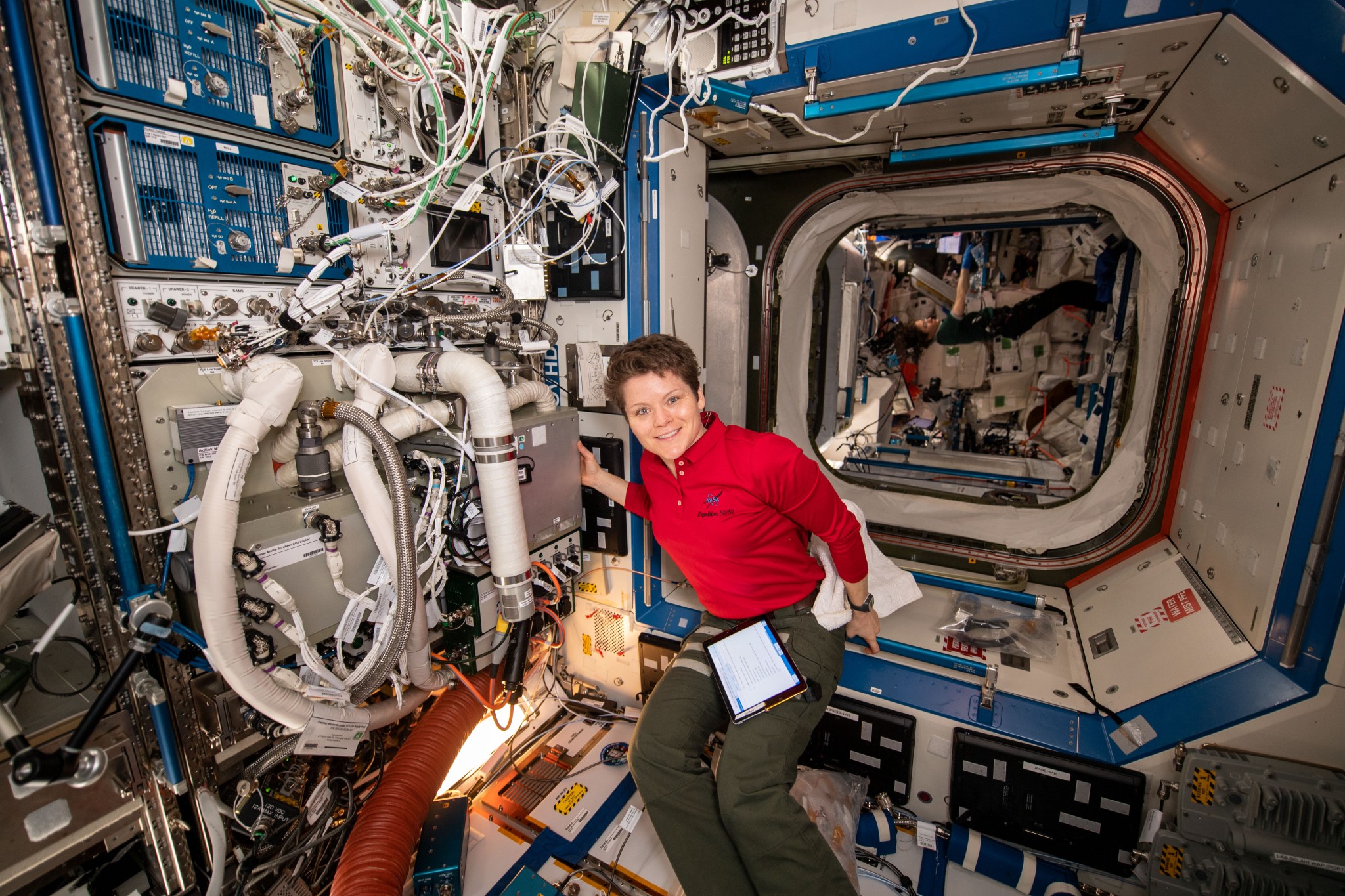
Existing Technology
Extravehicular Mobility Unit (EMU) CO2 Removal:
- When astronauts go on a Spacewalk/EVA (extravehicular activity), they build up CO2 levels from breathing into a small closed space.
- The spacesuit has a backpack system aboard called the PortableLife Support System (PLSS), which controls the environment of the spacesuit.
- One of the key functions of the PLSS is to remove and control CO2 delivered to the crewmember.
- CO2 washout is a method in which CO2 levels are controlled within the spacesuit helmet to limit the amount inhaled by a crewmember.
- The PLSS utilizes LiOHor METOX cartridges to absorb and eventually disperse the excess CO2.
- The lithium hydroxide cells are not regenerable and are exchanged after each EVA.
- The METOX cells are regenerable. They contain CO2 absorbent material. After each EVA they are placed into a vehicle oven that heats off the CO2 from adsorbent beds and vents it to the vehicle.
- The CDRA then absorbs the CO2 from the vehicle and vents into space.
- The spacesuit helmet also has an emergency purge valve to vent CO2 in emergency situations. This can adversely affect the O2 /CO2 balance.
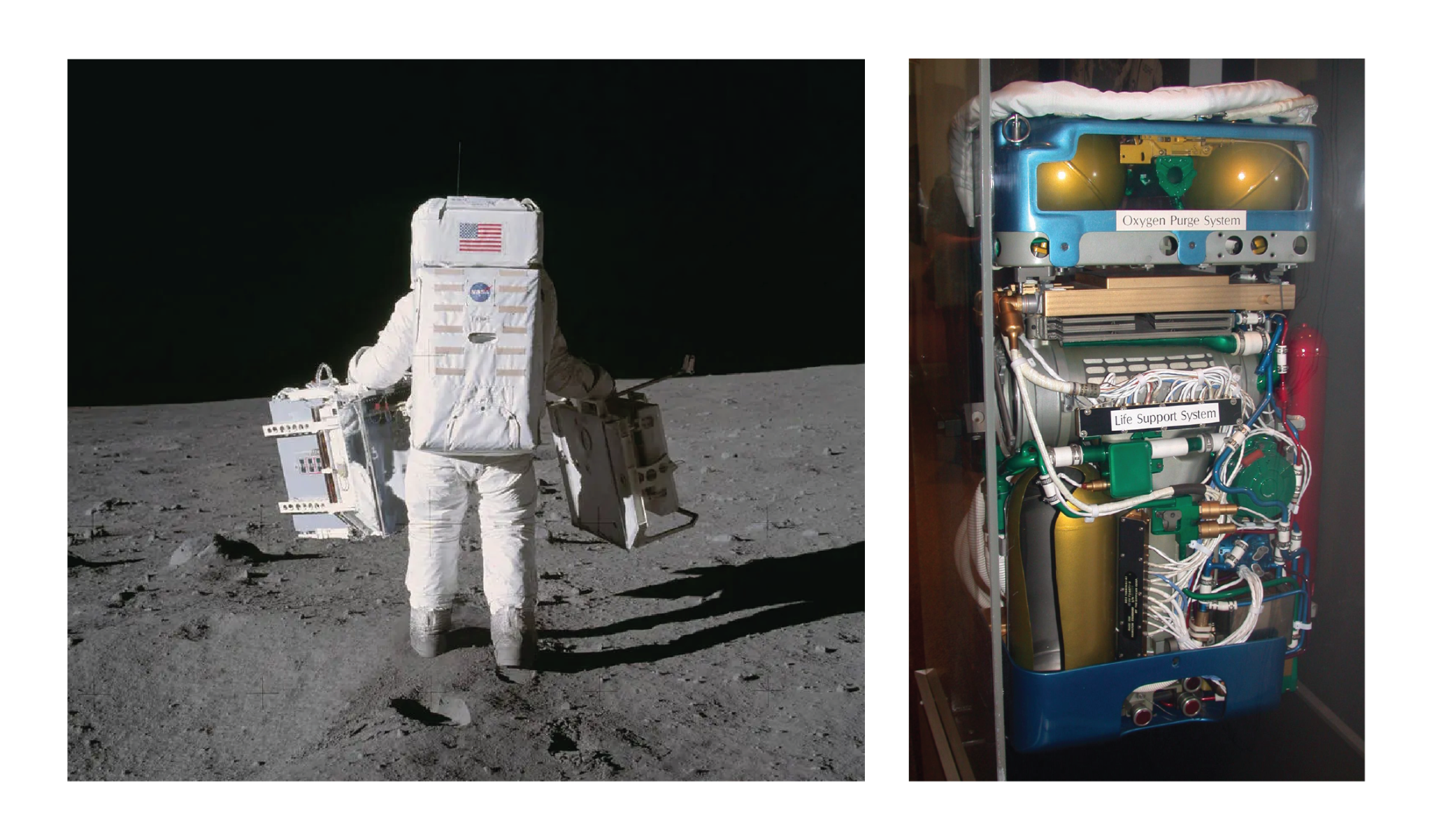
EMU Helmet Assembly
- Consists of: Transparent shell, Neck Ring, Vent Pad, Purge Valve and adjustable Valsalva Device.
- The Vent assembly diffuses incoming gas over the astronaut’s face.
- Under the EMU helmet, astronauts wear the communications carrier assembly, A.K.A. Snoopy Cap.
CO2 Washout System
- Carbon Dioxide washout describes the process of removing CO2 in an enclosed space. For the purpose of this brief, we are discussing CO2 washout in a spacesuit and space helmet.
- CO2 is a significant concern as the consequence of inadequate CO2 removal can result in hypercapnia and related symptoms ranging from headache and fatigue to impaired cognitive function and death.
- CO2 removal in a space helmet is challenging as it is difficult to ensure the quantity of CO2 that is removed from the suit and not forming pockets in any area of the suit or helmet. It is also important to ensure when CO2 is purged, it does not disrupt the critical breathable oxygen balance.
- Fresh air outlet from the PLSS is located at the rear base of the helmet. Air flow is directed from the
back of the crewmember’s head over their head and face into the suit where it exits the suit and flows into the PLSS for filtration. This provides a continuous airflow, so the exhaled CO2 is entrained with the fresh air loop from the PLSS. This mixed air then flows down into the suit to where it exits the suit and flows back into the PLSS. - Exhaled air including CO2 is flowed through an adsorbent charcoal bed and contamination control cartridges composed or either LiOH or METOX. This removes CO2, trace gases, and odors. The LiOH cartridges are stored on the vehicle and replaced on the ground, the METOX cartridges can be regenerated on orbit. Either of these are installed in the PLSS prior to EVA.
- To address the life support challenges, especially when considering future, longer space missions, NASA is developing an advanced portable life support system (APLSS) spacesuit for exploration. The ventilation loop of the APLSS is designed to assist with CO2 washout using a regenerable rapid cycle amine (RCA) removal system, efficient fan and heat exchange systems, and trace contaminant control (TCC) unit placed inside the suit hatch that allows for easy filter exchange.
- NASA has also developed a new system called the Integrated Ventilation Test System (IVTS) designed to study CO2 washout.
- The IVTS has a ventilation test loop as found in APLSS and suited manikin test apparatus (SMTA). The purpose is to supplement human testing, optimize CO2 removal efficiently, validate CO2 washout, evaluate spacesuit nitrogen efficiencies, and optimize the rapid cycle amine (RCA) performance for scrubbing CO2.
Mishaps
Apollo 13 –April 11-17, 1970
- Apollo 13 began their mission to land on and discover new information about the moon on April 11, 1970.
- Two days into their mission, a stir of the Service Module (SM) oxygen tank resulted in an electrical short causing the tank to explode, leaving the crew without adequate life support.
- The Lunar Module (LM), originally supplied for 2 of the crew to use for 2 days on the lunar surface, became a lifeboat supporting 3 crew for 4 days due to the SM’s inability to power the CM.
- CO2 levels quickly rose (14.9 mmHg) and it became apparent the LM did not have enough LiOH cylinders to support the crew for 4 days.
- Ground support identified that the CM had usable remaining LiOH cartridges, but they were not the same type/shape as the LM filters.
- The astronauts were instructed to use plastic bags, duct tape, and a suit hose to modify the filters, enabling them to absorb CO2 and support the 3- person crew. The CO2 levels dropped to 1 mmHg.
- The crew rationed supplies and water and used the minimum amount of power possible, allowing them to survive in the cold, dark LM for 4 days during their return to Earth.
- The objective of visiting the moon was aborted, but with significant ground support planning, the crew was able to transfer back to the CM and safely land.
Relevant Technical Requirements
[V2 6004] Nominal Vehicle/Habitat Carbon DioxideLevels The system shall limit the average 1-hour CO2 partial pressure (ppCO2) in the habitable volume to no more than 3 mmHg.
[V2 9001] Crew Interface Commonality Hardware and equipment performing similar functions shall have commonality of crew interfaces.
[V2 10005] Crew Interface Consistency The system shall provide crew interfaces that are consistent in appearance, arrangement, location, and operation throughout systems.
From: NASA-STD-3001 Volume 2, Rev D
Soyuz 23 –October 14, 1976
- The Soyuz 23 had an automatic docking system malfunction during the final approach to Salyut 5 due to an electronics failure.
- Cosmonauts had less than two days of battery power remaining and missed the landing opportunity for the day, so they powered down systems to conserve power.
- A blizzard was active in the landing zone forcing a lake rather than land landing.
- The descent module lowered in the dark on a single parachute which rocked as it entered the high winds of the landing area.
- They splashed down into the freezing water of Lake Tengiz, making recovery efforts extremely difficult.
- The cosmonauts stayed in the capsule with systems shut off to save power.
- As the capsule floated, the pressure equalization valve above the waterline provided air.
- The salt water from the lake caused the secondary chutes to deploy by shorting out the sensors, the parachute filled with water and dragged the capsule below the surface.
- The ventilation had to be closed to prevent water entering the vehicle.
- Finally, a helicopter, which could not lift the capsule due to water weight, was able to drag Soyuz 23 to the lake edge.
- The crew was found alive but incapacitated due to high CO2 levels
Relevant Technical Requirements
[V2 6004] Nominal Vehicle/Habitat Carbon DioxideLevels The system shall limit the average 1-hour CO2 partial pressure (ppCO2) in the habitable volume to no more than 3 mmHg.
[V2 6006] Total Pressure Tolerance Range for Indefinite Crew Exposure The system shall maintain the pressure to which the crew is exposed to between 34.5 kPa < pressure ≤ 103 kPa (5 psia < pressure ≤ 15.0 psia) for indefinite human exposure without measurable impairments to health or performance.
Referenced List
https://www.NASA.gov/sites/default/files/atoms/files/NASA-std-3001_vol_2_rev_b.pdf
- NASA-STD-3001 Volume 2 Revision D. (2023)
https://www.nasa.gov/wp-content/uploads/2023/11/nasa-std-3001-vol-2-rev-d-with-signature.pdf - Law J, Watkins S, Alexander D. (2010). In-Flight Carbon Dioxide Exposures and Related Symptoms: Association, Susceptibility, and Operational Implications. NASAScientificandTechnicalInformation(STI)ProgramOffice. NASA Internal Document NASA/TP–2010– 216126.
- Lee AG, Mader TH, Gibson CR, Tarver W, Rabiei P, Riascos RF, Galdamez LA, Brunstetter T. (2020). Spaceflight associated neuro-ocular syndrome (SANS) and the neuro-ophthalmologic effects of microgravity: a review and an update. NPJMicrogravity,6(7): 3771.
- Evidence Report: Risk of Spaceflight Associated Neuro-ocular Syndrome (SANS). (2017). HumanResearchProgram–HumanHealthCountermeasuresElement. NASA Internal Document.
- Basner M, Nasrini J, Hermosillo E, McGuire S, Dinges DF, Moore TM…& Bershad EM. (1985). Effects of – 12° head-down tilt with and without elevated levels of CO 2 on cognitive performance: the SPACECOT study. JournalofAppliedPhysiology,124(3): 750-760.
- Scully RR, Basner M, Nasrini J, Lam CW, Hermosillo E, Gur RC…& Ryder VE. (2019). Effects of acute exposures to carbon dioxide on decision making and cognition in astronaut-like subjects. NPJMicrogravity,5(127).
- Rodeheffer CD, Chabal S, Clarke JM, Fothergill DM. (2018). Acute Exposure to Low-to-Moderate Carbon Dioxide Levels and Submariner Decision Making. AerospaceMedicineandHumanPerformance,89(6): 520-525.
- Demontis GC, Germani MM, Caiani EG, Barravecchia I, Passino C, Angeloni D. (2017). Human Pathophysiological Adaptations to the Space Environment. FrontiersinPhysiology,8: 547.
- James JT. Chapter 7: Carbon Dioxide. In: Spacecraft Maximum Allowable Concentrations for Selected Airborne Contaminants. Volume 5 (2008), NationalResearchCounciloftheNationalAcademies.
- Astronaut Health and Performance. https://www.NASA.gov/centers/johnson/pdf/584739main_Wings- ch5d-pgs370-407.pdf
- Law J, Van Baalen M, Foy M, Mason SS, Mendez C, Wear ML, Meyers VE, Alexander D. (2014). Relationship between carbon dioxide levels and reported headaches on the International Space Station. JournalofOccupationalandEnvironmentalMedicine,56(5): 477-483.
- Widmaier EP, Hershel R, Strang KT. (2016). Vander’s Human Physiology: The Mechanisms of Body Function (14th ed.). New York: McGraw Hill. ISBN 9781259294099.
- Chullen,C, Conger,B Korona,A, Kanne,B Mcmillin,S, Paul,T, Norcross,J, Alonso,J, Swickrath,M, Utilizing a Suited Manikin Test Apparatus and spacesuit Ventilation Loop to Evaluate Carbon Dioxide Washout. JSC-CN-33276, Report Paper International Conference on Environmental Systems. July 12,2015
- NASA Extravehicular Mobility Unit (EMU) LSS/SSA Data Book. September 2017 UTC Aerospace Systems.
- Da Poian, A. T., El-Bacha, T. & Luz, M. R.M.P. (2010) Nutrient Utilization in Humans: Metabolism Pathways. Nature Education, 3(9):11.

























